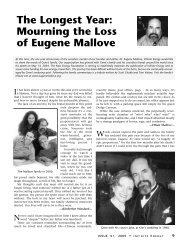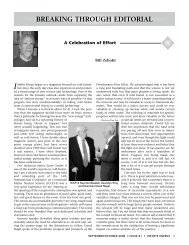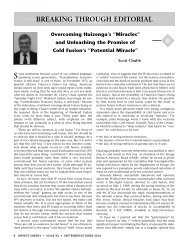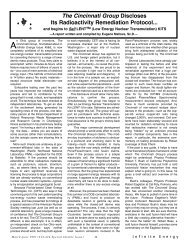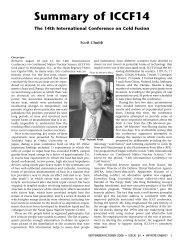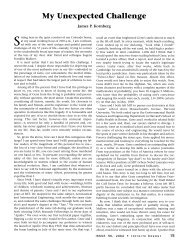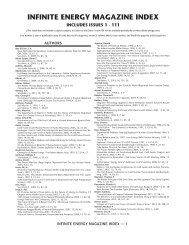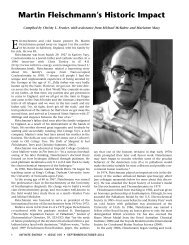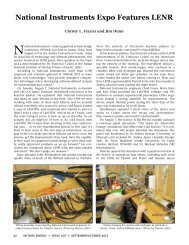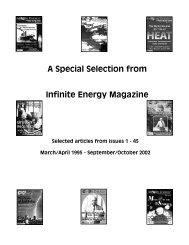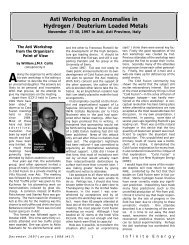MIT and Cold Fusion: A Special Report - Infinite Energy Magazine
MIT and Cold Fusion: A Special Report - Infinite Energy Magazine
MIT and Cold Fusion: A Special Report - Infinite Energy Magazine
You also want an ePaper? Increase the reach of your titles
YUMPU automatically turns print PDFs into web optimized ePapers that Google loves.
lished <strong>MIT</strong> paper <strong>and</strong> show the excess power produced by the<br />
Phase-II heavy water <strong>and</strong> light water cells. The raw signal was<br />
noisy <strong>and</strong> was averaged in hour-long intervals to produce the<br />
data (black dots) seen in these figures. The results rise <strong>and</strong> fall<br />
above the zero excess power line, <strong>and</strong> there is nothing that leaps<br />
out from this data comparison to suggest that excess power is<br />
being produced in the heavy water cell <strong>and</strong> not in the light<br />
water cell. It looks as though both excess power plots are about<br />
equally noisy. This data that form these curves was prepared at<br />
least as early as July 13, 1989, because I was given a draft article<br />
by the PFC that bears that date. [Ed. Note: See page 74.]<br />
On the other h<strong>and</strong>, I also was given the processed but unaveraged,<br />
<strong>and</strong> hence more noisy, data that went into forming these<br />
published curves. These data appear in the two other attached<br />
figures. The figures are copies of graphs that appear in another<br />
PFC draft report to me on calorimetry, dated July 10, 1989, three<br />
days before the draft with the averaged data. The light water<br />
graph oscillates above <strong>and</strong> below the zero excess power line<br />
(which I have introduced as a dotted line to make the comparison<br />
more clear), with no obvious bias above or below the zero<br />
line. There appear to be cyclic (24 hour?) variations in the presented<br />
excess power, but it is not clear what these are from. The<br />
heavy water curve by contrast is dominantly above the zero<br />
line, indicating the strong possibility of a residual excess power<br />
(even though the magnitude of the variation may be below the<br />
stated sensitivity, 40 milliwatts). The two curves are simply<br />
quite different. There could be something like a few tens of milliwatts<br />
excess power here, on average, as one PFC researcher<br />
agreed there could be. For this 0.1 centimeter diameter electrode,<br />
9 cm long, 20 milliwatts would translate to excess power<br />
of 0.28 watts per cubic centimeter.<br />
So why do we see no evidence of this possible excess power in<br />
the graphs that are in the final report <strong>and</strong> the published paper?<br />
The inescapable answer seems to be that the averaged data for<br />
the heavy water was moved down an arbitrary amount so that it<br />
now has more the appearance of the null result in the case of the<br />
light water averaged data. Interestingly, the light water averaged<br />
data seem to be consistent in level with the corresponding curve<br />
of raw processed data, that is, it has not been moved down.<br />
I am planning to prepare an article for <strong>Fusion</strong> Technology that<br />
will address some of these data analysis issues.<br />
Lessons<br />
The recent turn of events in the David Baltimore-Imanishi<br />
Kari-Margot O’Toole affair offers some lessons for <strong>MIT</strong> on the<br />
matter of cold fusion. This is brought home most effectively by<br />
Dr. Baltimore’s recent apology to Dr. O’Toole. As quoted in The<br />
Tech (May 5, 1991), Baltimore said, “I recognize that I may well<br />
have been blinded to the full implications of the mounting evidence<br />
by an excess of trust, <strong>and</strong> I have learned from this experience<br />
that one must temper trust with a healthy dose of skepticism.<br />
This entire episode has reminded me of the importance of<br />
humility in the face of scientific data.” Clearly many <strong>MIT</strong> scientists<br />
who have recklessly attacked honest efforts to come to<br />
grips with a possible new phenomenon have lacked “humility<br />
in the face of scientific data.”<br />
Another pertinent comment was recently made by Professor<br />
William F. Schreiber of Electrical Engineering <strong>and</strong> Computer<br />
Science. Writing on the Baltimore affair in the <strong>MIT</strong> Faculty<br />
Newsletter (April 1991), he said: “A name on a paper implies<br />
responsibility for its contents. We certainly ought not to appear<br />
as authors of work we have not watched carefully enough to<br />
know whether or not it is correct.”<br />
Employment Prospects<br />
[Editor’s Note: non-relevant sections of this part of resignation<br />
letter omitted for brevity.]<br />
. . .Working at the <strong>MIT</strong> News Office as Chief Science Writer has<br />
been a great privilege <strong>and</strong> an enlarging experience for me. The<br />
vistas that have opened up are immense <strong>and</strong> the talented people<br />
<strong>and</strong> friends I have come to know are many. I wish that the <strong>MIT</strong><br />
community had been able to react with less acrimony <strong>and</strong> divisiveness<br />
in the matter of cold fusion. I will not reconsider my<br />
decision to leave the News Office unless that situation changes<br />
radically, something I do not foresee happening soon. But I am<br />
deeply grateful to both of you for having selected me in the summer<br />
of 1987 to fill the important role of science writer, <strong>and</strong> I<br />
appreciate that you have always respected my abilities <strong>and</strong><br />
sought my perspectives. But circumstances dictate a moving on.<br />
Whatever may transpire, I hope to stay in touch with you <strong>and</strong><br />
perhaps even work with you in some new capacity in the future.<br />
Science <strong>Report</strong>ing Suggestions<br />
[Editor’s Note: non-relevant sections of this part of resignation letter<br />
omitted for brevity.]<br />
. . .Difficult as some of these matters are to hear about, I hope<br />
this airing of views has been helpful to you <strong>and</strong> will lead to beneficial<br />
changes within <strong>MIT</strong>. You have been great people to work<br />
with. (Even though this letter is being given to you today, it was<br />
written in nearly its present form on May 24, 1991).<br />
Sincerely, Eugene F. Mallove<br />
Exhibit M<br />
Eugene Mallove’s Formal Request for <strong>MIT</strong> PFC Raw Data<br />
June 14, 1991<br />
Following my resignation from the New Office, I attempted, in<br />
vain, to get the data that Prof. Parker had promised me at the<br />
public forum on June:<br />
To:<br />
Professor Ronald Parker, Director<br />
Plasma <strong>Fusion</strong> Center, <strong>MIT</strong><br />
From: Dr. Eugene F. Mallove, Bow, New Hampshire<br />
Date: June 14, 1991<br />
Re: Data Required for Further Evaluation of the <strong>MIT</strong> <strong>Cold</strong><br />
<strong>Fusion</strong> Calorimetry Experiment<br />
In response to your offer to provide data that I might request<br />
concerning the cold fusion calorimetry experiments carried out<br />
in the spring of 1989 at the PFC, I would appreciate receiving<br />
the following items:<br />
(1) The unpublished Phase-II experiment heater power curve<br />
for the H 2 O case, corresponding to the D 2 O heater power curve<br />
that was published.<br />
(2) Copies of all laboratory notebook pages relating to the PFC<br />
calorimetry experiments on cold fusion, both Phase-I <strong>and</strong> Phase-II.<br />
(3) An explanation of why the hour-interval-average excess<br />
power curve for the case of the D 2 O Phase-II experiment is centered<br />
around the zero excess power level, when the processed<br />
data (before time- averaging) on Dr. Luckhardt’s memo of July<br />
10, 1989 are almost entirely above the zero excess power line. A<br />
memo dated July 13, 1989 is where this apparent change occurs,<br />
<strong>and</strong> that is the graph that was published.<br />
(4) An exact data-processing <strong>and</strong> mathematical description of<br />
how the excess heater power curves were arrived at from raw<br />
experimental measurements.<br />
(5) Calculations, if any, that provide a thermal analysis for heat<br />
37 <strong>Infinite</strong> <strong>Energy</strong> • ISSUE 24, 1999 • <strong>MIT</strong> <strong>Special</strong> <strong>Report</strong>



